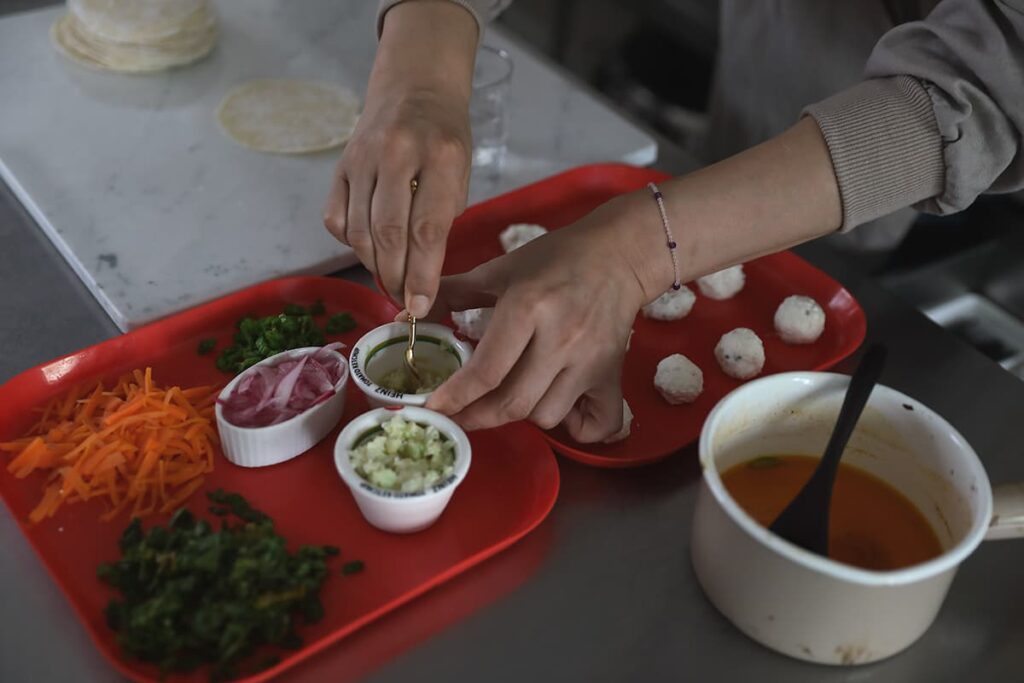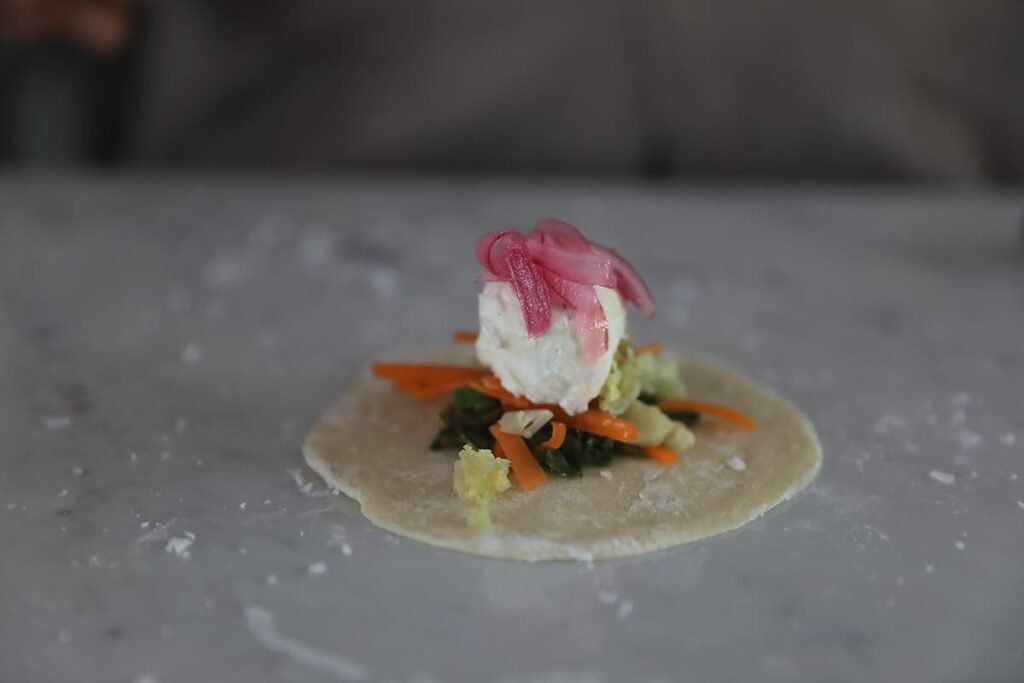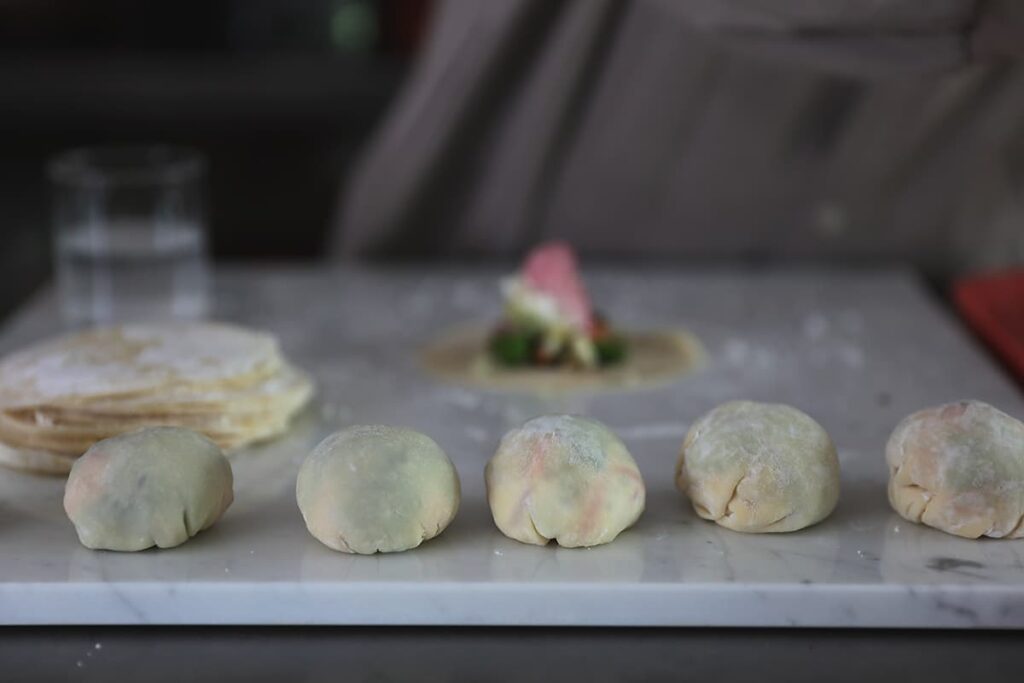インド編
dumplings|2024.07.24

「旅する餃子」第5回目はインド編。
インドと聞けば多くの人が思い浮かべるカレー。しかし、それだけではない。インドの食には多彩な魅力がある。それを餃子にしたらどんな味?


多用なスパイスを使いながら、多彩に広がるインド料理。
身近なようでいて、でも実際に行った人はそんなにいない。不思議な距離感がある国、インド。 馴染みがあるように感じるのは、いまでは日本の国民食といっても過言ではないカレーのおかげかもしれない。他に、インドと聞いて何を思いつくだろう。 絢爛豪華な宮殿やインド象、学生の頃の教科書に載っていたガンジー、ガンジス川での沐浴、ヨガやさまざまな修行など。 ファッションだとターバンやサリー。最近ではボリウッドと呼ばれるインド映画も人気で、インド史上最高の約97億円という驚きの制作費をかけた「RRR」がヒットした。
14億人以上もの人口を抱えたインドは料理も多彩。 スパイスを多用したものが基本だが料理法や味は地域により違い、大きく分けて「北インド料理」「南インド料理」「ベンガル料理」「ゴア料理」の4つの種類がある。ちなみに日本でもお馴染みのナンやチャパティー、タンドリーチキンは北インド料理。
食べ方としては、インドでは一般的に右手を使って食べることがマナーとなっている。 これはヒンズー教やイスラム教では左手は不浄とされているからで、ナイフやフォークなどの食器は使わずに右手で直接、食べ物をつかんで食べる。
ライフスタイルも食文化も、日本からは大きくかけ離れているインド。そこにもし餃子があったら。 またまた松井の想像が膨らんでいった。 エキゾチックな魅力にあふれた彼女の国を思い、できた餃子は、はたしてどんな味?
Indian cuisine: A tapestry of flavors through spices.
Our familiarity with India despite the country feeling distant and being visited by few may be due to curry’s popularity in Japan. India evokes also images of magnificent palaces, elephants, Gandhi, the Ganges, yoga, and ascetic practices. And in fashion, turbans and saris. Recently, Bollywood has also gained popularity, with the hit movie “RRR” costing a record of 9.7 billion yen. With a population of over 1.4 billion, India boasts a diverse cuisine characterized by the liberal use of spices. Cooking methods and flavors vary by region, and can be broadly categorized into four types: North Indian cuisine, South Indian cuisine, Bengali cuisine, and Goan cuisine. Familiar dishes in Japan like naan, chapati, and tandoori chicken are North Indian.
In India, it’s customary to eat with the right hand, as the left is considered unclean in Hinduism and Islam. Utensils like knives and forks are rarely used; food is directly grasped and eaten with the right hand.
India’s lifestyle and food culture greatly differ from Japan’s. What if there were dumplings? Matsui imagines their taste, inspired by India’s exotic charm.


カレーじゃないのに、しっかりインドが感じられる。
インドに餃子があったら、味はカレーだろうと誰もが思う。だが、そうはならないのが松井の想像力。
松井はまず、タージ・マハールというとんでもない建築物を皇帝に造らせた王妃ムムターズ・マハルをイメージ。 彼女の魔性をスパイスで表現するため、華やかでいてスッキリした、ちょっと強気なカルダモンを使用した。餡には、それぞれに下ごしらえをした野菜をレイヤーに重ね、それを丸く包むことで、モスクの屋根を形づくり、 さらに夕景のタージマハールの水路を想わせるサフランのスープに浸す。
材料を詳しく説明すると、まず皮はシルキーになるように牛乳を練り込む。 餡は、菜食主義者が多いインドらしく肉を使わずに、カッテージチーズにすりつぶしたカルダモンを加え、ケールとニンジンとシシトウはスチームしてギーと和え、 カリフラワーを牛乳で煮込み、ニンニクと生姜をギーを炒めたソースと赤玉ねぎのアチャールでできている。さて、お味のほうは?
अपने भोजन का आनंद लिजिये
まず、 見た目がキレイで食欲がそそられる。 味は、カレーでないのにしっかりインドを感じる。香りの女王といわれるカルダモンがいい仕事をしていて、 スパイシーで複雑な味わいなのに、全体が雑になることなくうまくまとまっている。 餃子を食べながら、 インドの新しい魅力を発見したような気になった。
Not curry, but still distinctly evoking India.
One would expect Indian dumplings to be curry flavored, but Matsui’s imagination works differently.
Matsui envisions Mumtaz Mahal, the empress for whom the Taj Mahal was commissioned. To express her allure, Matsui uses vibrant, refreshing and slightly assertive cardamom. For the filling, she layers pre-prepared vegetables, wrapping them to resemble the dome of a mosque, then immersing them in a broth reminiscent of the Taj Mahal’s canals at sunset.
The dough is kneaded with milk to give it a silky texture. The vegetarian filling includes cottage cheese with ground cardamom, steamed kale, carrots, shishito peppers with ghee, cauliflower simmered in milk, and a sauce made using garlic, ginger, and ghee, with a side of pickled red onions. So, how do the dumplings taste?
The dumplings are beautiful and appetizing. Though not curry, their taste distinctly evokes India. Cardamom, the “queen of spices,” adds a spicy, complex, well-balanced flavor. Eating the dumplings feels like discovering a new charm of India.

《料理家》 松井まり子 Mariko Matsui
株式会社De-De
Senior Art Director/Graphic Designer/Food Stylist
アートディレクター、フードスタイリストとして活動する傍ら2024年にはDe-De GYOZAもスタート。




